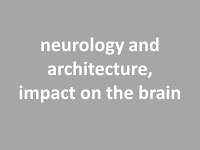The concept of neuromorphic architecture is based on the existence of interactions between the human brain and the built environment. Fred Gage, an American professor, neuroscientist and precursor of brain neuroplasticity, observed that “although the brain controls our behavior and genes control brain structure, the environment can modulate the function of genes and ultimately the structure of the brain and therefore can change our behavior. The architectural design changes our brains and behavior”.
The theory of mind and the theory of mirror neurons help in understanding the relationship between neuroscience and architecture. They try to explain how the built environment affects human emotions, behavioral and physiological responses, and social relationships. It helps to understand the genesis of empathy and emotions in contact with the inanimate environment, material and spatial phenomena. It explains how a picture consisting of paint on canvas and a building made from inanimate matter can make us feel tormented, happy, bored or positively stimulated. There are buildings that delight us, add positive energy and also those which create disgust, disappointment or even irritability.
The identification of features of the built environment for patients with central nervous system (CNS) dysfunction is based on defining the relationship between physical (architectural) features and the set of social, organizational and relative features of space. By maintaining a balance between the needs and reactions of patients to the environment, the perception of the environment and patient dignity and security, creation of space is needed to meet the needs of patients with CNS dysfunction.
Any structural or functional disorders of the CNS changes perception of an environment. Changes may affect selected senses and result in a change in an individual’s behavior.
Neuromorphic architecture provides the ability to create a proper living space for patients with CNS diseases. It utilizes results of research in neuroscience in the pre-design process, according to the evidence-based approach.
The following are the recommendations for the design of space and facilities for patients with CNS dysfunction: personalized hospital rooms, appropriate choice of colors of walls and furniture, use of simple functional equipment, proper esthetics of the environment, individual adaptation of objects for patients with various dysfunctions (e.g. hemiparesis, hemineglect syndrome, hemianopsia homonyma, cognitive impairment). Particular attention should be paid to the location of such equipment as mirrors and TV sets, adaptation of the environment to the handicapped (elimination of architectural barriers) and protection from collapse, other injuries (no sharp edges) or the possibility of a suicide attempt (secure windows).
Proper design of space can reduce the hospital stay of patients with CNS dysfunction; it helps with therapy and rehabilitation, reduces the need for psychoactive drugs, and positively influences the patient’s behavior [1–5].
In conclusion, the authors tried to present a new approach to interactions between architecture and neuroscience. First of all, the concept of neuromorphic architecture is being redefined. Therefore, the central point in the basis of every new creation of space (built environment) is reserved for a human whose world is a combination of various stimuli and memories. The built environment is supposed to respond to human needs.



